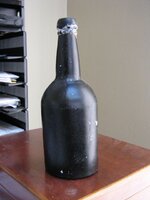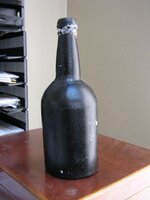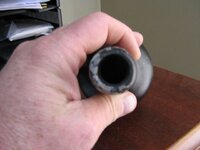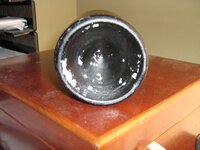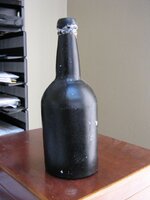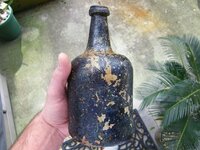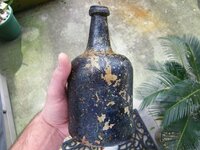sorry about first post still look ing for help to id thanks mark
Navigation
Install the app
How to install the app on iOS
Follow along with the video below to see how to install our site as a web app on your home screen.
Note: This feature may not be available in some browsers.
More options
You are using an out of date browser. It may not display this or other websites correctly.
You should upgrade or use an alternative browser.
You should upgrade or use an alternative browser.
bottle found water
- Thread starter maxxfish
- Start date
timekiller
Silver Member
- Feb 10, 2009
- 3,852
- 964
- 🥇 Banner finds
- 1
- Detector(s) used
- Minelab E-Trac
- Primary Interest:
- All Treasure Hunting
It's a cylinder in form,some are called squat cylinder.(wine,rum,beer,etc) Made after 1760-70.Also yours looks like I see mold seems from a three piece mold.If so mid to late 1800's & into the early 1900's for some types.
Take Care,
Pete,
Here is what one would look like around 1740 I found.Called a english mallet.No mold seems.
http://www.sha.org/bottle/body.htm
Also you may find this part of the forum here on T-net helpful.
http://forum.treasurenet.com/index.php/topic,231917.0.html
Three-piece mold body seams: In conjunction with the true two-piece mold, one of the earliest mold types to be used in the U.S. was the "three-piece mold" which was likely first used in about 1814, patented by the Henry Ricketts (Bristol, England) in 1821 or 1822, and likely adapted into the U.S. by the 1830s (McKearin & Wilson 1978; Hume 1991). Although earlier versions of a three-piece mold may pre-date the Rickett's mold it is not certain. If so, they would have been essentially a dip mold with two shoulder mold sections added. Rickett's patent added several other features, including hinged shoulder parts and foot controls for opening and closing the mold, both of which were significant improvements in efficiency (Jones 1986). The Rickett's mold also consisted of at least four parts - two opposing shoulder parts, dip mold body portion, and a moveable base plate which could be changed to achieve different base configurations or for different embossing. This was likely the first plate mold (McKearin & Wilson 1978, Jones 1983). Most true Rickett's produced bottles are embossed on the base with H. RICKETT'S & CO. GLASS WORKS BRISTOL, date between 1821 and the 1850s, and usually have a sand pontil scar.
Morphologically, typical three-piece mold bottles have a horizontal mold seam encircling the bottle where the shoulder and body meet and two mold seams on opposite sides running vertically from the shoulder seam, up the shoulder, and variably up the neck and/or finish. Click on the picture of a light amethyst liquor bottle below to view a close-up of the very distinct mold seams on the shoulder and neck of this later mouth-blown, three-piece mold liquor bottle dating from the early 20th century (1900-1910). Consider the location of the mold seams in the picture with the conformation of the three-piece mold in the illustration above. Three-piece mold liquor bottles were a popular style and manufacturing method into the early 20th century and are shown in catalogs dating until at least 1908 (Illinois Glass Co. 1908).
The vertical body side seams on earlier (1821 to about 1840) three-piece mold bottles disappear right at the junction of the shoulder and neck (Jones 1986). This is typical of the early Ricketts' bottles which were not molded above this point; the neck instead being formed by glassblower manipulation. The olive green bottle pictured to the right is an early sand pontiled Ricketts' liquor bottle which is blob sealed and dated (1822). This bottle is also embossed H. RICKETT'S & CO. GLASS WORKS BRISTOL on the base and PATENT on the shoulder. The horizontal shoulder seam is faint but in evidence as well as the vertical shoulder seams, which both terminate right at the neck-shoulder junction indicating that the neck and finish were both hand formed. It should be noted that similar (though usually a bit taller and smaller in diameter) three-piece molded cylindrical bottles with PATENT embossed on the shoulder were widely made and used for spirits in the U. S. from the 1830s to 1870s. Click Tall, moderately slender bodied, straight neck "Patent" style spirits cylinder (mid-19th century) for more information on these bottles.
Later vertical side mold seams end immediately below the base of the applied finish (about 1840 through the 1880s). The latest three-piece mold bottles (1890s into the 1910s) have tooled finishes with the vertical side mold seams ending on the upper portion of the neck or in the finish itself, i.e. end just beyond where the lipping tool ended. The liquor bottle pictured to the left has the side mold seams ending within the finish if one looks closely. Three-piece mold bottles are not embossed on the body of the bottle, though as noted above may have embossing on the shoulder (common), neck (unusual), and/or base (also common).
Most bottles which are commonly referred to as three-piece molds were actually made in a mold that had a fourth base plate piece, like noted above for the Rickett's bottles. Use of a separate base piece probably made construction of the mold easier. Although most three-piece mold bottles actually had four mold parts, referring to them as "three-piece" molds will continue due to its ubiquitous use over the years, similar to the two-piece mold discussed earlier. To suggest changing the name would be confusing and unproductive since most people understand what is being referred to (Toulouse 1969b). The four-piece mold is a variation of the three-piece mold with two body halves instead of one; this mold type is discussed in the box below.
An unusual, though minor, variation of the standard three-piece mold conformation is as discussed and pictured at the following link: http://www.bottlemysteries.com/2008/08/bottle-mystery-key-lock-on-a-shoulder-seam-bottle-mark/ This three-piece mold style included small locking flange points where the two upper halves connected or "locked" with the lower "dip" portion of the mold. This is evidenced by the squared off mold seam discontinuity that disrupts the horizontal shoulder seam on each side of these bottles - one in the middle of each of the two upper mold parts - with a corresponding "lock" portion on the immediately opposing upper surface of the lower mold part. These type bottles are rarely encountered and seem to date only from the pre-Civil War period, i.e., 1830-1860. See the image and discussion at the above link for more information.
Three part mold with three body-mold leaves: This mold type is a distinct variation of the above described three-piece mold with a very different orientation to the mold portions. Instead of the single body mold and split (two-part) shoulder/neck molds like described for the typical three-piece mold bottle, this three-piece mold is composed of three more or less equal sized pieces that fit together along vertical seams, i.e. three equal mold "leaves' that produce a bottle that has three vertical mold seams from heel to upper neck or finish. One of the mold pieces was typically attached permanently to the base plate, with the other two hinged so that they could open to insert a gather and to extract the blown item. The base can be either of a "post-bottom" or "cup-bottom" design (McKearin & McKearin 1941; Toulouse 1969b). This type mold is referred to as a three-piece "leaf" mold on this website.
Take Care,
Pete,

Here is what one would look like around 1740 I found.Called a english mallet.No mold seems.
http://www.sha.org/bottle/body.htm
Also you may find this part of the forum here on T-net helpful.
http://forum.treasurenet.com/index.php/topic,231917.0.html
Three-piece mold body seams: In conjunction with the true two-piece mold, one of the earliest mold types to be used in the U.S. was the "three-piece mold" which was likely first used in about 1814, patented by the Henry Ricketts (Bristol, England) in 1821 or 1822, and likely adapted into the U.S. by the 1830s (McKearin & Wilson 1978; Hume 1991). Although earlier versions of a three-piece mold may pre-date the Rickett's mold it is not certain. If so, they would have been essentially a dip mold with two shoulder mold sections added. Rickett's patent added several other features, including hinged shoulder parts and foot controls for opening and closing the mold, both of which were significant improvements in efficiency (Jones 1986). The Rickett's mold also consisted of at least four parts - two opposing shoulder parts, dip mold body portion, and a moveable base plate which could be changed to achieve different base configurations or for different embossing. This was likely the first plate mold (McKearin & Wilson 1978, Jones 1983). Most true Rickett's produced bottles are embossed on the base with H. RICKETT'S & CO. GLASS WORKS BRISTOL, date between 1821 and the 1850s, and usually have a sand pontil scar.
Morphologically, typical three-piece mold bottles have a horizontal mold seam encircling the bottle where the shoulder and body meet and two mold seams on opposite sides running vertically from the shoulder seam, up the shoulder, and variably up the neck and/or finish. Click on the picture of a light amethyst liquor bottle below to view a close-up of the very distinct mold seams on the shoulder and neck of this later mouth-blown, three-piece mold liquor bottle dating from the early 20th century (1900-1910). Consider the location of the mold seams in the picture with the conformation of the three-piece mold in the illustration above. Three-piece mold liquor bottles were a popular style and manufacturing method into the early 20th century and are shown in catalogs dating until at least 1908 (Illinois Glass Co. 1908).
The vertical body side seams on earlier (1821 to about 1840) three-piece mold bottles disappear right at the junction of the shoulder and neck (Jones 1986). This is typical of the early Ricketts' bottles which were not molded above this point; the neck instead being formed by glassblower manipulation. The olive green bottle pictured to the right is an early sand pontiled Ricketts' liquor bottle which is blob sealed and dated (1822). This bottle is also embossed H. RICKETT'S & CO. GLASS WORKS BRISTOL on the base and PATENT on the shoulder. The horizontal shoulder seam is faint but in evidence as well as the vertical shoulder seams, which both terminate right at the neck-shoulder junction indicating that the neck and finish were both hand formed. It should be noted that similar (though usually a bit taller and smaller in diameter) three-piece molded cylindrical bottles with PATENT embossed on the shoulder were widely made and used for spirits in the U. S. from the 1830s to 1870s. Click Tall, moderately slender bodied, straight neck "Patent" style spirits cylinder (mid-19th century) for more information on these bottles.
Later vertical side mold seams end immediately below the base of the applied finish (about 1840 through the 1880s). The latest three-piece mold bottles (1890s into the 1910s) have tooled finishes with the vertical side mold seams ending on the upper portion of the neck or in the finish itself, i.e. end just beyond where the lipping tool ended. The liquor bottle pictured to the left has the side mold seams ending within the finish if one looks closely. Three-piece mold bottles are not embossed on the body of the bottle, though as noted above may have embossing on the shoulder (common), neck (unusual), and/or base (also common).
Most bottles which are commonly referred to as three-piece molds were actually made in a mold that had a fourth base plate piece, like noted above for the Rickett's bottles. Use of a separate base piece probably made construction of the mold easier. Although most three-piece mold bottles actually had four mold parts, referring to them as "three-piece" molds will continue due to its ubiquitous use over the years, similar to the two-piece mold discussed earlier. To suggest changing the name would be confusing and unproductive since most people understand what is being referred to (Toulouse 1969b). The four-piece mold is a variation of the three-piece mold with two body halves instead of one; this mold type is discussed in the box below.
An unusual, though minor, variation of the standard three-piece mold conformation is as discussed and pictured at the following link: http://www.bottlemysteries.com/2008/08/bottle-mystery-key-lock-on-a-shoulder-seam-bottle-mark/ This three-piece mold style included small locking flange points where the two upper halves connected or "locked" with the lower "dip" portion of the mold. This is evidenced by the squared off mold seam discontinuity that disrupts the horizontal shoulder seam on each side of these bottles - one in the middle of each of the two upper mold parts - with a corresponding "lock" portion on the immediately opposing upper surface of the lower mold part. These type bottles are rarely encountered and seem to date only from the pre-Civil War period, i.e., 1830-1860. See the image and discussion at the above link for more information.
Three part mold with three body-mold leaves: This mold type is a distinct variation of the above described three-piece mold with a very different orientation to the mold portions. Instead of the single body mold and split (two-part) shoulder/neck molds like described for the typical three-piece mold bottle, this three-piece mold is composed of three more or less equal sized pieces that fit together along vertical seams, i.e. three equal mold "leaves' that produce a bottle that has three vertical mold seams from heel to upper neck or finish. One of the mold pieces was typically attached permanently to the base plate, with the other two hinged so that they could open to insert a gather and to extract the blown item. The base can be either of a "post-bottom" or "cup-bottom" design (McKearin & McKearin 1941; Toulouse 1969b). This type mold is referred to as a three-piece "leaf" mold on this website.
Attachments
Upvote
0
Top Member Reactions
-
 3466
3466 -
 1958
1958 -
 1920
1920 -
 1164
1164 -
 1134
1134 -
 987
987 -
 867
867 -
 853
853 -
 803
803 -
 795
795 -
 745
745 -
 646
646 -
 578
578 -
 576
576 -
 486
486 -
 439
439 -
 425
425 -
E
410
-
 397
397 -
 391
391
Users who are viewing this thread
Total: 2 (members: 0, guests: 2)


